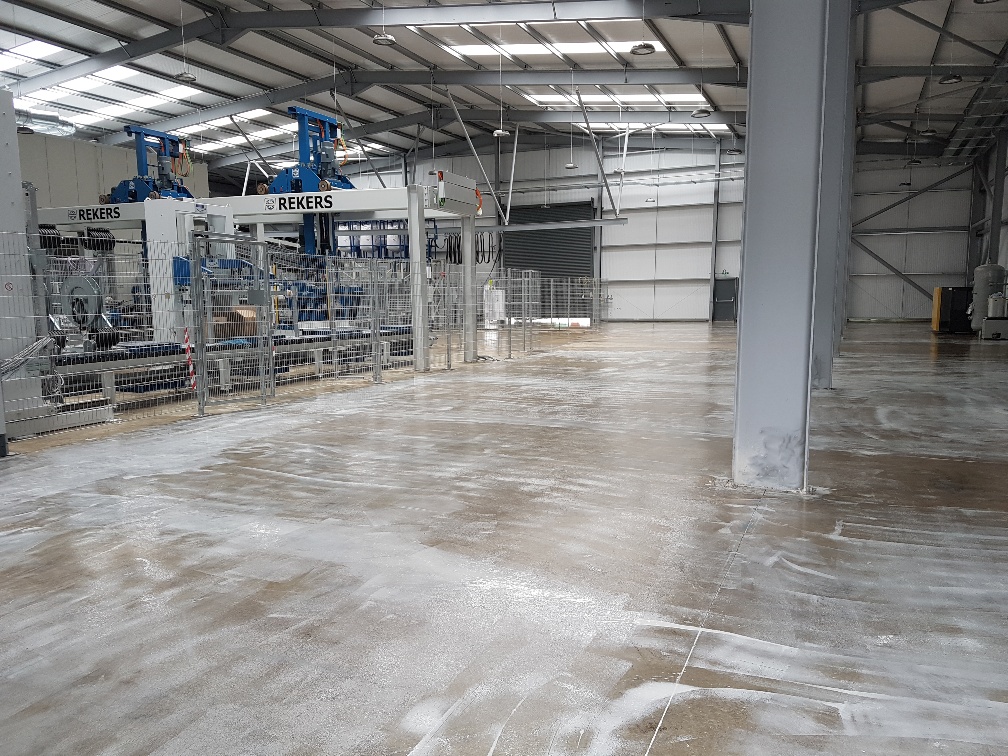How to Apply an Epoxy Coating Over an Existing Vinyl Floor

How to Apply an Epoxy Coating Over an Existing Vinyl Floor
Many of our customers ask about applying an epoxy floor coating over existing vinyl flooring, both in sheet form and tiles. As many have experienced, as vinyl flooring gets old and/or well-used, the heat-welded seams often burst open, allowing contamination to seep through and under the flooring. It also becomes porous and difficult to keep clean.
Many of our customers ask about applying an epoxy floor coating over existing vinyl flooring, both in sheet form and tiles. As many have experienced, as vinyl flooring gets old and/or well-used, the heat-welded seams often burst open, allowing contamination to seep through and under the flooring. It also becomes porous and difficult to keep clean.
Can you put epoxy over vinyl flooring?
Yes, you can apply epoxy over vinyl flooring – as long as you have the right knowledge, materials, and follow the proper steps. While vinyl presents some challenges for epoxy application, a well-prepared surface and the correct approach can result in a durable, high-performance floor.
The key to success is ensuring the vinyl is properly adhered to the subfloor, thoroughly cleaned, and sufficiently abraded to create a strong bond. Contaminants, moisture, and existing coatings (such as wax or polish) must be removed to prevent adhesion issues.
Read on for expert advice on preparation, surface treatment, and choosing the best epoxy system. And if you need further guidance, our team is always available to help.
Yes, you can apply epoxy over vinyl flooring – as long as you have the right knowledge, materials, and follow the proper steps. While vinyl presents some challenges for epoxy application, a well-prepared surface and the correct approach can result in a durable, high-performance floor.
The key to success is ensuring the vinyl is properly adhered to the subfloor, thoroughly cleaned, and sufficiently abraded to create a strong bond. Contaminants, moisture, and existing coatings (such as wax or polish) must be removed to prevent adhesion issues.
Read on for expert advice on preparation, surface treatment, and choosing the best epoxy system. And if you need further guidance, our team is always available to help.
How to Remove Existing Vinyl Flooring
Removing vinyl flooring can be a real headache for several reasons:
Residual Adhesive
Vinyl flooring is often securely adhered to the subfloor, making removal difficult. When you do manage to lift it, you’ll find either hard glue or soft glue underneath… and both can cause problems!
- Soft glue: Soft adhesives are problematic as they gum up diamond grinders and wire brushes. Chemical removal can turn them into a sticky mess. The best removal method is using an STR Machine, otherwise, you’re relying on hand scrapers.
- Hard glue: Hard adhesives can be even more difficult to remove. The best approach depends on the amount left on the surface, requiring tools like a Handheld Diamond Grinder, High-Speed Diamond Grinder, or a Scabbler. We’d always recommend a discussion before setting out to remove hard glue.
Poor-Quality Substrate
The next issue is not just what is left on the surface by way of the glue, but what gets pulled up when removing the vinyl.
Many businesses opt for vinyl flooring due to issues with the underlying subfloor, so when pulling up the vinyl, most people also end up pulling any latex or self-levelling screeds previously used to level out the surface. This creates two problems: glue residue on the surface and holes or loose screeds. Both of these needs addressing before applying epoxy.
Removing vinyl flooring can be a real headache for several reasons:
Residual Adhesive
Vinyl flooring is often securely adhered to the subfloor, making removal difficult. When you do manage to lift it, you’ll find either hard glue or soft glue underneath… and both can cause problems!
- Soft glue: Soft adhesives are problematic as they gum up diamond grinders and wire brushes. Chemical removal can turn them into a sticky mess. The best removal method is using an STR Machine, otherwise, you’re relying on hand scrapers.
- Hard glue: Hard adhesives can be even more difficult to remove. The best approach depends on the amount left on the surface, requiring tools like a Handheld Diamond Grinder, High-Speed Diamond Grinder, or a Scabbler. We’d always recommend a discussion before setting out to remove hard glue.
Poor-Quality Substrate
The next issue is not just what is left on the surface by way of the glue, but what gets pulled up when removing the vinyl.
Many businesses opt for vinyl flooring due to issues with the underlying subfloor, so when pulling up the vinyl, most people also end up pulling any latex or self-levelling screeds previously used to level out the surface. This creates two problems: glue residue on the surface and holes or loose screeds. Both of these needs addressing before applying epoxy.
How to Deal With Surface Contamination
Vinyl flooring is widely used in environments exposed to grease, moisture, and other contaminants – such as kitchens, bathrooms, food processing facilities, factories, garages, and laboratories. These floors are often chosen for their reputation as being completely impervious and non-slip. However, in greasy or wet conditions, achieving proper adhesion for any coating can be challenging. For this reason, it’s essential to use an appropriate biodegradable degreaser before applying any coating.
To ensure a clean surface:
- Use a biodegradable degreaser – see Degrease IT.
- Remove and re-lay any loose vinyl and repair any holes.
- Once the surface is clean and dry, perform a final abrasion to create a key for the epoxy to adhere properly.
Vinyl flooring is widely used in environments exposed to grease, moisture, and other contaminants – such as kitchens, bathrooms, food processing facilities, factories, garages, and laboratories. These floors are often chosen for their reputation as being completely impervious and non-slip. However, in greasy or wet conditions, achieving proper adhesion for any coating can be challenging. For this reason, it’s essential to use an appropriate biodegradable degreaser before applying any coating.
To ensure a clean surface:
- Use a biodegradable degreaser – see Degrease IT.
- Remove and re-lay any loose vinyl and repair any holes.
- Once the surface is clean and dry, perform a final abrasion to create a key for the epoxy to adhere properly.
How to Key the Surface for Better Adhesion
If you choose to apply epoxy over vinyl, keying the surface is crucial. This involves thoroughly abrading the flooring to promote adhesion.
- Small areas: Use an orbital sander with something like 60-grit sandpaper.
- Larger areas: An STR Machine is strongly recommended.
Floors that have been polished and/or waxed (especially in schools and colleges, hospitals and hotels) will need more than a simple abrasion. An STR Machine or a Vacuum Assisted Grinder can help to ensure layers of wax/polish are sufficiently ‘cut’ through
If you choose to apply epoxy over vinyl, keying the surface is crucial. This involves thoroughly abrading the flooring to promote adhesion.
- Small areas: Use an orbital sander with something like 60-grit sandpaper.
- Larger areas: An STR Machine is strongly recommended.
Floors that have been polished and/or waxed (especially in schools and colleges, hospitals and hotels) will need more than a simple abrasion. An STR Machine or a Vacuum Assisted Grinder can help to ensure layers of wax/polish are sufficiently ‘cut’ through
How to Fill Holes and Surface Imperfections
After preparation, any holes, gaps, or damaged areas should be repaired before applying epoxy. Popular repair products include:
Once repairs are complete and cured, the surface is ready for coating.
After preparation, any holes, gaps, or damaged areas should be repaired before applying epoxy. Popular repair products include:
Once repairs are complete and cured, the surface is ready for coating.
How to Choose the Right Epoxy Coating
There are many factors to take into consideration when choosing a coating for your vinyl flooring. Selecting the best epoxy coating depends on:
- The type of vinyl flooring
- The intended use of space
- The level of wear and tear expected
If the existing vinyl flooring consists of multiple colours, its likely that several coats will be needed to stop the colours coming through.
For a durable, high-wear, and easy-to-clean finish, we recommend the following system:
- One coat of WD Primer
- One coat of Flortex Professional
There are many factors to take into consideration when choosing a coating for your vinyl flooring. Selecting the best epoxy coating depends on:
- The type of vinyl flooring
- The intended use of space
- The level of wear and tear expected
If the existing vinyl flooring consists of multiple colours, its likely that several coats will be needed to stop the colours coming through.
For a durable, high-wear, and easy-to-clean finish, we recommend the following system:
- One coat of WD Primer
- One coat of Flortex Professional

How Long Does it Take to Install Epoxy Over Vinyl Flooring?
The time required to install an epoxy coating over vinyl flooring depends on several factors, including the size of the area, the extent of surface preparation needed, environmental conditions, and the products used. As a general guide:
Day 1 – Surface Preparation & Priming
Cleaning, degreasing, and keying the surface can all be completed on day 1. We recommend priming first, as it helps identify areas that need repairs.
Day 1 – Repairing Imperfections
Once the primer is applied on day 1, any surface imperfections – such as holes or loose vinyl – can be repaired. If conditions are suitable, Easi-Fil can be used and will cure in just 20 minutes.
Day 2 – Applying the Epoxy Coating or Topcoat
After prep, coatings can be applied on day 2.
Day 3 – Curing and Foot Traffic
If using our most popular epoxy coating, Flortex professional, your surface will be able to tolerate foot traffic on day 3 – 24 hours after application.
Day 4 – Done!
48 hours after application, your surface will be ready for vehicular traffic and will reach full chemical cure in 7 days.
The time required to install an epoxy coating over vinyl flooring depends on several factors, including the size of the area, the extent of surface preparation needed, environmental conditions, and the products used. As a general guide:
Day 1 – Surface Preparation & Priming
Cleaning, degreasing, and keying the surface can all be completed on day 1. We recommend priming first, as it helps identify areas that need repairs.
Day 1 – Repairing Imperfections
Once the primer is applied on day 1, any surface imperfections – such as holes or loose vinyl – can be repaired. If conditions are suitable, Easi-Fil can be used and will cure in just 20 minutes.
Day 2 – Applying the Epoxy Coating or Topcoat
After prep, coatings can be applied on day 2.
Day 3 – Curing and Foot Traffic
If using our most popular epoxy coating, Flortex professional, your surface will be able to tolerate foot traffic on day 3 – 24 hours after application.
Day 4 – Done!
48 hours after application, your surface will be ready for vehicular traffic and will reach full chemical cure in 7 days.
How Long Will an Epoxy Floor Last Over Vinyl?
When properly applied, an epoxy coating over vinyl can last 5 to 10 years or more, depending on the level of foot traffic and maintenance. Factors that influence longevity include:
- The quality of the surface preparation: A well-prepared vinyl surface ensures better adhesion and durability.
- The environment: Areas with heavy machinery, high footfall, or chemical exposure may wear faster.
- Regular maintenance: Cleaning with non-abrasive, non-corrosive products extends the lifespan of the coating.
For schools, factories, or commercial spaces with high traffic, applying a protective topcoat or anti-slip additive can further enhance durability and performance.
When properly applied, an epoxy coating over vinyl can last 5 to 10 years or more, depending on the level of foot traffic and maintenance. Factors that influence longevity include:
- The quality of the surface preparation: A well-prepared vinyl surface ensures better adhesion and durability.
- The environment: Areas with heavy machinery, high footfall, or chemical exposure may wear faster.
- Regular maintenance: Cleaning with non-abrasive, non-corrosive products extends the lifespan of the coating.
For schools, factories, or commercial spaces with high traffic, applying a protective topcoat or anti-slip additive can further enhance durability and performance.
Is it Cheaper to Apply Epoxy Over Vinyl or Replace the Vinyl?
We often get asked if its more cost effective to simply replacing the vinyl altogether. We know cost is a big factor in this sort of decision, so here’s a quick cost comparison:
- Epoxy over vinyl really is typically much cheaper, since it eliminates the cost of vinyl removal and subfloor repairs. The main expenses include surface preparation, epoxy materials, and labour.
- Vinyl replacement is usually more expensive, as it involves removal costs, subfloor levelling, and purchasing new vinyl flooring and is not as durable or long lasting as epoxy flooring.
In many cases, properly applied epoxy provides a more durable and cost-effective alternative. However, if the existing vinyl is in extremely poor condition, replacing it might be the better long-term investment.
Think of it like fixing up an old car – sometimes a repair job keeps it going strong, but if the whole thing really is falling apart, it might be time for an upgrade!
We often get asked if its more cost effective to simply replacing the vinyl altogether. We know cost is a big factor in this sort of decision, so here’s a quick cost comparison:
- Epoxy over vinyl really is typically much cheaper, since it eliminates the cost of vinyl removal and subfloor repairs. The main expenses include surface preparation, epoxy materials, and labour.
- Vinyl replacement is usually more expensive, as it involves removal costs, subfloor levelling, and purchasing new vinyl flooring and is not as durable or long lasting as epoxy flooring.
In many cases, properly applied epoxy provides a more durable and cost-effective alternative. However, if the existing vinyl is in extremely poor condition, replacing it might be the better long-term investment.
Think of it like fixing up an old car – sometimes a repair job keeps it going strong, but if the whole thing really is falling apart, it might be time for an upgrade!
Need further technical assistance?
Call our technical team on 01234 846 780 or email uksales@polycote.com. We have a fully qualified team ready to offer practical advice on any flooring project.









